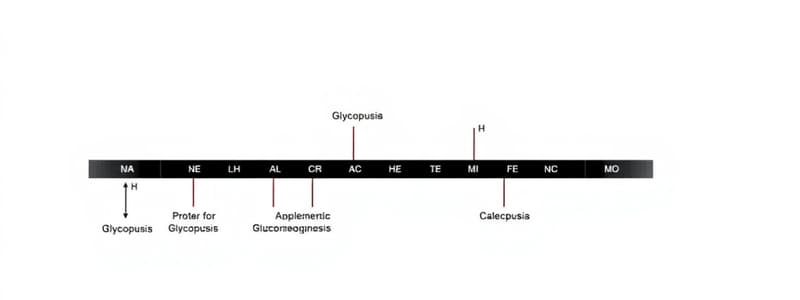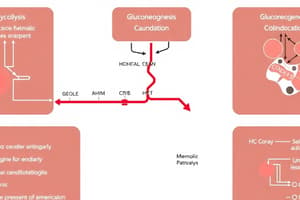Podcast
Questions and Answers
Match each enzyme with its corresponding step in glycolysis:
Match each enzyme with its corresponding step in glycolysis:
Hexokinase = Phosphorylation of glucose to glucose-6-phosphate Phosphofructokinase-1 (PFK-1) = Phosphorylation of fructose-6-phosphate to fructose-1,6-bisphosphate Pyruvate Kinase = Transfer of phosphate from PEP to ADP, forming pyruvate and ATP Glyceraldehyde-3-Phosphate Dehydrogenase (GAPDH) = Oxidation and phosphorylation of glyceraldehyde-3-phosphate to 1,3-bisphosphoglycerate
Match each enzyme with its role in gluconeogenesis:
Match each enzyme with its role in gluconeogenesis:
Pyruvate Carboxylase = Conversion of pyruvate to oxaloacetate (OAA) PEP Carboxykinase (PEPCK) = Conversion of oxaloacetate (OAA) to phosphoenolpyruvate (PEP) Fructose-1,6-bisphosphatase (FBPase-1) = Dephosphorylation of fructose-1,6-bisphosphate to fructose-6-phosphate Glucose-6-phosphatase = Dephosphorylation of glucose-6-phosphate to glucose
Match the following regulatory molecules with their effect on Phosphofructokinase-1 (PFK-1):
Match the following regulatory molecules with their effect on Phosphofructokinase-1 (PFK-1):
AMP = Activates PFK-1 ATP = Inhibits PFK-1 Citrate = Inhibits PFK-1 Fructose-2,6-bisphosphate (F2,6BP) = Activates PFK-1
Match the regulatory effect to the appropriate enzyme in gluconeogenesis:
Match the regulatory effect to the appropriate enzyme in gluconeogenesis:
Match each step with its ATP consumption or production in glycolysis:
Match each step with its ATP consumption or production in glycolysis:
Match the reaction type to the enzyme involved in glycolysis:
Match the reaction type to the enzyme involved in glycolysis:
Match each enzyme with its corresponding location:
Match each enzyme with its corresponding location:
Match the hormone with its effect on glycolysis and gluconeogenesis:
Match the hormone with its effect on glycolysis and gluconeogenesis:
Match the following compounds with their role in regulating glycolysis or glucogenesis:
Match the following compounds with their role in regulating glycolysis or glucogenesis:
Match the tissue with its primary role in either Glycolysis or Gluconeogenesis:
Match the tissue with its primary role in either Glycolysis or Gluconeogenesis:
Flashcards
Hexokinase/Glucokinase
Hexokinase/Glucokinase
Glucose is phosphorylated to glucose-6-phosphate (G6P), trapping it inside the cell and committing it to glycolysis. Uses ATP and is irreversible.
Phosphoglucose Isomerase
Phosphoglucose Isomerase
G6P is isomerized to fructose-6-phosphate (F6P), preparing it for the next phosphorylation step. It is a reversible reaction.
Phosphofructokinase-1 (PFK-1)
Phosphofructokinase-1 (PFK-1)
F6P is phosphorylated to fructose-1,6-bisphosphate (F1,6BP). The major regulatory point of glycolysis, it uses ATP and is irreversible.
Aldolase
Aldolase
Signup and view all the flashcards
Triose Phosphate Isomerase
Triose Phosphate Isomerase
Signup and view all the flashcards
Glyceraldehyde-3-Phosphate Dehydrogenase (GAPDH)
Glyceraldehyde-3-Phosphate Dehydrogenase (GAPDH)
Signup and view all the flashcards
Phosphoglycerate Kinase
Phosphoglycerate Kinase
Signup and view all the flashcards
Phosphoglycerate Mutase
Phosphoglycerate Mutase
Signup and view all the flashcards
Enolase
Enolase
Signup and view all the flashcards
Pyruvate Kinase
Pyruvate Kinase
Signup and view all the flashcards
Study Notes
- Glycolysis and gluconeogenesis are central metabolic pathways.
- Glycolysis breaks down glucose to pyruvate, while gluconeogenesis synthesizes glucose from pyruvate and other precursors.
- These pathways are reciprocally regulated to maintain glucose homeostasis.
Glycolysis Steps
- Glycolysis occurs in the cytoplasm and consists of ten enzymatic steps.
- Step 1: Hexokinase/Glucokinase: Glucose is phosphorylated to glucose-6-phosphate (G6P).
- Hexokinase is found in most tissues
- Glucokinase is found in the liver and pancreas.
- This traps glucose inside the cell and commits it to glycolysis
- ATP is consumed, and the reaction is irreversible.
- Step 2: Phosphoglucose Isomerase: G6P is isomerized to fructose-6-phosphate (F6P).
- This reaction is reversible
- It prepares the molecule for the next phosphorylation step.
- Step 3: Phosphofructokinase-1 (PFK-1): F6P is phosphorylated to fructose-1,6-bisphosphate (F1,6BP).
- PFK-1 is the major regulatory point of glycolysis
- ATP is consumed, and the reaction is irreversible.
- Step 4: Aldolase: F1,6BP is cleaved into two 3-carbon molecules: glyceraldehyde-3-phosphate (GAP) and dihydroxyacetone phosphate (DHAP).
- The reaction is reversible.
- Step 5: Triose Phosphate Isomerase: DHAP is converted to GAP.
- This ensures that both products of the aldolase reaction can proceed through the rest of glycolysis.
- The reaction is reversible.
- Step 6: Glyceraldehyde-3-Phosphate Dehydrogenase (GAPDH): GAP is oxidized and phosphorylated to 1,3-bisphosphoglycerate (1,3BPG).
- NAD+ is reduced to NADH.
- This is the first energy-yielding step in glycolysis
- The reaction is reversible.
- Step 7: Phosphoglycerate Kinase: 1,3BPG transfers a phosphate group to ADP, forming ATP and 3-phosphoglycerate (3PG).
- This is substrate-level phosphorylation.
- The reaction is reversible.
- Step 8: Phosphoglycerate Mutase: 3PG is converted to 2-phosphoglycerate (2PG).
- The reaction is reversible.
- Step 9: Enolase: 2PG is dehydrated to form phosphoenolpyruvate (PEP).
- The reaction is reversible.
- Step 10: Pyruvate Kinase: PEP transfers its phosphate group to ADP, forming ATP and pyruvate.
- This is another substrate-level phosphorylation.
- The reaction is irreversible and is another major regulatory point.
Gluconeogenesis Steps
- Gluconeogenesis occurs mainly in the liver and, to a lesser extent, in the kidneys.
- It involves several enzymes and reactions that bypass the irreversible steps of glycolysis.
- Pyruvate to Phosphoenolpyruvate (PEP): Bypasses pyruvate kinase and involves two enzymes.
- Pyruvate Carboxylase: Pyruvate is converted to oxaloacetate (OAA) in the mitochondria.
- Requires ATP and biotin as a cofactor.
- PEP Carboxykinase (PEPCK): OAA is converted to PEP.
- This can occur in the mitochondria or cytoplasm, depending on the species and tissue.
- GTP is consumed.
- Pyruvate Carboxylase: Pyruvate is converted to oxaloacetate (OAA) in the mitochondria.
- Fructose-1,6-bisphosphate to Fructose-6-phosphate: This bypasses phosphofructokinase-1 (PFK-1).
- Fructose-1,6-bisphosphatase (FBPase-1): F1,6BP is dephosphorylated to F6P.
- This reaction is irreversible and is a major regulatory point.
- Fructose-1,6-bisphosphatase (FBPase-1): F1,6BP is dephosphorylated to F6P.
- Glucose-6-phosphate to Glucose: This bypasses hexokinase/glucokinase.
- Glucose-6-phosphatase: G6P is dephosphorylated to glucose in the endoplasmic reticulum.
- This enzyme is present in the liver and kidney but absent in muscle and brain
- This explains why these tissues cannot release free glucose into the bloodstream.
- Glucose-6-phosphatase: G6P is dephosphorylated to glucose in the endoplasmic reticulum.
Regulation of Glycolysis
- Glycolysis is regulated at three key irreversible steps: hexokinase/glucokinase, PFK-1, and pyruvate kinase.
- Hexokinase/Glucokinase Regulation:
- Hexokinase is inhibited by its product, G6P.
- Glucokinase is not inhibited by G6P directly but is regulated by glucose levels and is induced by insulin.
- PFK-1 Regulation:
- Activated by AMP and fructose-2,6-bisphosphate (F2,6BP).
- Inhibited by ATP and citrate.
- F2,6BP is a potent allosteric activator
- Its levels are controlled by the enzyme PFK-2/FBPase-2.
- Pyruvate Kinase Regulation:
- Activated by fructose-1,6-bisphosphate (feedforward activation).
- Inhibited by ATP and alanine.
- Liver pyruvate kinase is also regulated by phosphorylation; it is inactivated when phosphorylated by protein kinase A in response to glucagon.
Regulation of Gluconeogenesis
- Gluconeogenesis is regulated at the irreversible steps catalyzed by pyruvate carboxylase, PEPCK, and fructose-1,6-bisphosphatase.
- Pyruvate Carboxylase Regulation:
- Activated by acetyl-CoA.
- When energy is high, acetyl-CoA accumulates, signaling the need to store glucose.
- PEPCK Regulation:
- Transcription of the PEPCK gene is increased by glucagon and cortisol.
- Fructose-1,6-bisphosphatase Regulation:
- Inhibited by AMP and fructose-2,6-bisphosphate (F2,6BP).
- Citrate activates FBPase-1.
Reciprocal Regulation
- Glycolysis and gluconeogenesis are reciprocally regulated to prevent futile cycling.
- Fructose-2,6-bisphosphate (F2,6BP):
- This is a key regulator.
- It activates PFK-1 (glycolysis) and inhibits FBPase-1 (gluconeogenesis).
- F2,6BP levels are controlled by a bifunctional enzyme, PFK-2/FBPase-2.
- PFK-2 phosphorylates F6P to form F2,6BP
- FBPase-2 hydrolyzes F2,6BP back to F6P.
- The activity of PFK-2/FBPase-2 is regulated by hormones:
- Insulin activates PFK-2, increasing F2,6BP levels and stimulating glycolysis.
- Glucagon activates FBPase-2, decreasing F2,6BP levels and stimulating gluconeogenesis.
- Hormonal Control:
- Insulin promotes glucose utilization by stimulating glycolysis and inhibiting gluconeogenesis.
- Glucagon promotes glucose production by stimulating gluconeogenesis and inhibiting glycolysis.
- Energy Charge:
- High ATP levels inhibit glycolysis and stimulate gluconeogenesis.
- High AMP levels stimulate glycolysis and inhibit gluconeogenesis.
Energetics
- Glycolysis:
- Net ATP production: 2 ATP per glucose molecule (2 ATP consumed, 4 ATP produced).
- 2 NADH produced per glucose molecule.
- Gluconeogenesis:
- Requires energy: 6 ATP equivalents per glucose molecule (2 ATP for pyruvate carboxylase, 2 GTP for PEPCK, 2 ATP for phosphoglycerate kinase).
- Consumes 2 NADH.
Importance
- Glycolysis is essential for energy production, especially in tissues with limited mitochondria (e.g., red blood cells) or during intense exercise.
- Gluconeogenesis is crucial for maintaining blood glucose levels during fasting, starvation, and prolonged exercise.
- It provides glucose to the brain and other tissues that rely on it as a primary energy source.
Studying That Suits You
Use AI to generate personalized quizzes and flashcards to suit your learning preferences.




